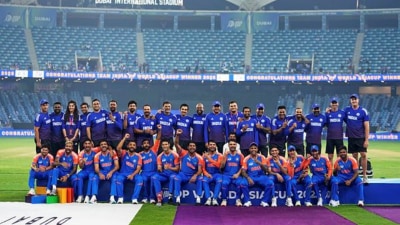As Xiaomi brings its most expensive phone yet— the Xiaomi 14 Ultra— to India, the country is divided. At the one end, there’s a collective sigh of relief that Xiaomi has finally launched a premium flagship phone, alongside making a bunch of other announcements all centred around “premiumisation” of the market. On the other side, there’s talk of who will buy a 1 lakh Xiaomi phone and if Xiaomi is in fact, also overcharging its customers. But regardless of what side you’re on, you can’t contest that Xiaomi finally has a plan and a new-found level of confidence, to make a big splash in the flagship phone market.
We sat with Xiaomi India chief marketing officer, Anuj Sharma, the morning after its big Xiaomi 14 series launch event in the National Capital, to make a sense of everything— why the 14 Ultra costs 1 lakh, who should buy it, but even more importantly, where does Xiaomi go from here. Excerpts.
Firstly, congratulations on [finally] making a splash in the premium phone category. The Xiaomi 14 Ultra was probably the industry’s best kept secret. Let’s start with availability. You’ve consciously kept stocks limited in the past. What is the status for the Xiaomi 14 and Xiaomi 14 Ultra?
Anuj: Getting the Xiaomi 14 and 14 Ultra [to India] is a conscious decision. What we did with the 13 Pro, now we’re splitting that audience so people who wanted to get the 13 Pro but couldn’t because Rs 80,000 was a little too much, with the 14, it becomes a lot more accessible. We’re expecting to sell at least about three to four times more 14s than the 13 Pro. And so, we are planning the supply in such a way that we can meet that demand.
For the Xiaomi 14 Ultra, it [stock] is in evaluation process. It’s a completely new price point for us. We still have a month [for sale to go live] which is a luxury by Xiaomi standards. We never really have this kind of timeline. So, we’re looking at what we can do in a month’s time. We are opening the Xiaomi 14 Ultra Reserve Edition on the 11th [of March] for pre-booking. That is going to be super limited. I don’t know if I can put that number out yet but it’s a small number. It comes with a whole bunch of things [in the box] which also need to be put together. The 14 Ultra is obviously a big step. So, we’ll see how it does and how many true photographers are out there [who would buy it].
With the 14, I’m hoping that we should be able to supply [for the demand]. The 14 ultra is an experiment for us. We don’t want to over-forecast in any manner.
While you say that it’s an experiment, but it also appears that you’re putting your foot down this year and getting serious about the premium flagship space. Or at least, that’s what all your announcements seem to suggest.
Anuj: We’re fairly confident about the device[s], but we also have to be cognizant of the fact that there’s a large audience that’s not seen Xiaomi at the Rs 1 lakh price point. The 14 ultra is going to be a device that may not be for everyone unless you are a serious photographer. Unless you understand the optics and unless you are capable of getting the most out of that system, you’re going to be utilizing only 30-40% of what it’s capable of. For most people, the 14 might be more than enough. So that’s how we’re looking at it. The overall response that we’ve got on the 14 series wherever it’s launched has also given us a lot of confidence. The last time we launched an Ultra was without Leica optics. That was 2021. And at that point, the gap between the Xiaomi 11 Ultra and essentially any of the top two flagships was not as much as the gap is today. We launched the 11 ultra at 70k. I think you were getting other devices at about 1 lakh. Today, this is at 1 lakh, but everyone else has gone to like a 1 lakh 50. So, it starts becoming [more] value for money from a flagship perspective.
Of course you’re [still] undercutting Apple and Samsung in pricing, but there’s growing chit-chatter that Xiaomi is now “overcharging” people in India for the 14 series. What do you have to say to that?
Anuj: The innovation and R&D do not come cheap and that is reflected in the cost of the device[s]. The whole is more than the sum of its parts. With the Xiaomi 14 series, we are talking to the innovators and the early adopters. The mass majority will wait for these guys and then they will just follow through. I remember back in 2016-17, the same set of people used to complain about the Apple devices— Why would I pay 60-70k for the iPhone 6S Plus? Now, those guys are willing to line up to get a device which is almost reaching three times that cost. The majority of the folks are looking at somebody else to tell them if it’s good or not, and we see this as a 2 to 3-year process before everyone else starts realizing this. Even after that also, you may or may not like it. Not everyone has to like the same movie. Not everyone has to like the same car. Not everyone has to like the same phone. Personally, I’m super excited because this is just the start of the Xiaomi-Leica journey and in just two years, we’ve come so far. Imagine what will happen in the future.
Leica cameras are also super expensive. So in a way the Xiaomi 14 and 14 Ultra are probably the most affordable entry-point to using an “actual” Leica camera?
Anuj: That’s a little hard to put. The cheapest Leica camera in India which is the Q3 is about Rs 4.65 lakhs. On the other side, we are also cognizant of the fact that it’s unfair to compare. I don’t think it will be right for us to say what you get on that Leica camera, you’re getting here. It’s not. You just cannot. The physics of it all will not get you there. All we’re trying to do is, to bridge the gap. These phones sit somewhere in the middle of smartphone photography, and what those cameras are capable of. We [have] just started to depart [from] where the [conventional] smartphone photography is, but there’s still a long distance [to cover]. And I’m hoping with the Xiaomi x Leica Optical Institute, we’ll get closer. But at the end of it, I don’t think we can discount the physics.
The Xiaomi 14 Ultra Reserve Edition doesn’t bundle the full photography kit. Will you launch it separately in India?
Anuj: The photography kit is not coming to India. Because of the electronics that are built into it, it will require a separate set of certifications which we don’t have yet. But the most exciting part about the photography kit which is the ability to put different filters is still there [in the Reserve Edition box].
Will it be possible to buy these filters separately?
Anuj: No, they will be available with the Xiaomi 14 Ultra Reserve Edition only.
Xiaomi priority club is another interesting initiative you’re launching alongside the 14 series? How do you sign-up for it and will there be any charges?
No. There are certain set of devices [flagship phones and TVs] that, the moment you buy into that device, you are part of the priority club. The list includes: Mi 11 Ultra, Xiaomi 12 Pro, Xiaomi 13 Pro and Xiaomi 14 series, Mi QLED TV 75, Xiaomi OLED Vision TV 55, and Xiaomi Smart TV X 65 2023.
I see you’re wearing the Xiaomi Band 8 Pro. Nice. Whatever happened with that and why does Xiaomi not launch its bands in India anymore? Any update on Xiaomi Watch S3 and Watch 2?
Anuj: People want to hear the word watch more than a band now. There are a lot of watches out there which do less than what a band could do and less accurately versus what a band could do. But unfortunately, this is the larger messaging that’s kind of leading them astray. And because of that, we’ve held back on the band launches in India. Everywhere else in the world, our bands are still doing really well. Since the first Mi band, people have loved them for the accuracy, the details and of course the battery life. So, it’s going to be a tough one. We’re trying to see how we can straddle between band and watch. But watch is an area that we are actively working on [to bring to India]. We’re hoping to start looking at it [more actively] this year to see what we can do on the watch side. India, unfortunately from a wearables perspective, is running a very different tune versus the rest of the world. Right now, it’s in the downward price spiral which is at least from what we’re seeing, there’s a severe compromise on quality. Till that can be solved for, we’ll have to probably see how we tread these waters.
And what about foldables? Are you considering them for India launch? What are the challenges?
Anuj: We’re considering [foldables]. But there are still certain things that we need to iron out until that happens. It’s a little tough, but we are considering. There’s a lot of R&D that goes in right from the panel to the glass that you need to do. At the moment there are three aspects of a foldable device that don’t really work too well in the Indian market. First is that they are very expensive, so the entry barrier is so high that for me to experience a proper fold, I need to go well beyond [a price point] where a super flagship could come. The second aspect is the build itself in terms of how thick it is and the weight that’s another barrier for mass adoption. People are not very comfortable with something that’s more than half a pound or quarter of a kg in their pocket. That also needs to be solved. And the third one is essentially, how do you solve for the dust? Because these are foldable devices, they unfortunately also come with a certain amount of fragility, and in a country like ours, it’s very easy to get dust inside when you’re folding it which can lead to more failures. So, till we solve for price, form factor and the sturdiness, they are still going to be slightly niche.
Follow FE Tech Bytes on Twitter, Instagram, LinkedIn, Facebook.









